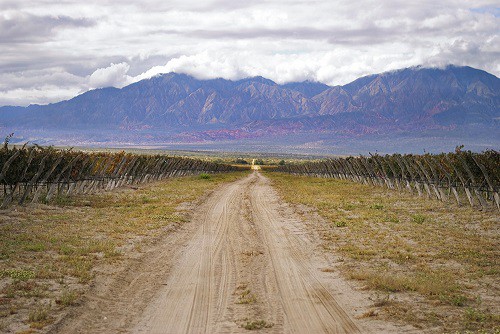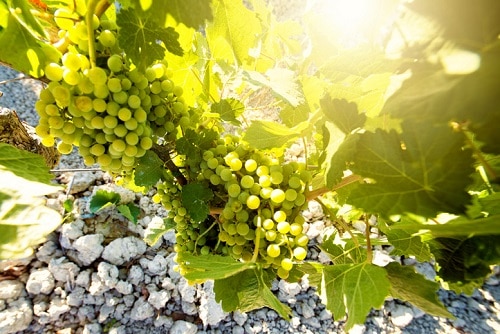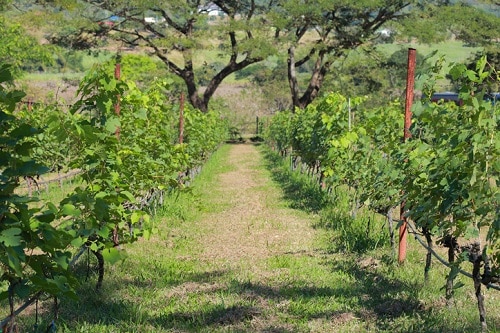Torrontés Grape Variety & Wine Profile
The Torrontés Triplets
(pronounced tor-RON-tez)
Torrontés is Argentina’s sole native grape and might be the perfect viticultural expression for a country whose romantic and sentimental traditions are never too far from a celebration. Although to outsiders Torrontés may seem like another obscure wine popularized by the wine geek revolution, it has an ancient lineage dating back to the first grapevines planted in the Americas. When the Spanish missionaries arrived in Argentina, they brought them cuttings of Moscatel de Alejandria and Criolla Chica, aka Mission grape for the production of altar wine and planted these varieties side-by-side. Later they crossed to give birth to “The Torrontés Triplets:” Torrontés Riojano, Torrontés Sanjuanino, and Torrontés Mendocino.
For many years no one could tell them apart, probably because they were always planted, harvested, and vinified together. However, through happenstances, they were separated, and Torrontés Mendocino went to Mendoza, Torrontés Sanjuanino went to San Juan, and Torrontés Riojano went to Cafayate. It was then that their unique traits came to light. Over the years, there have been many different names for Torrontés that mostly originate from memories of other grapes that reminded Spanish and Italian immigrants of wine from their homeland. In San Juan, Torrontés was called Malvasía; and in Mendoza, it was called Moscato d’Asti.
RELATED: Discover Great Itineraries and Wineries To Visit in Argentina on the Free Winetraveler App
Torrontés Tasting Notes
Today, Torrontés Riojano is considered the fairest of the Torrontés Triplets having the greatest potential for making quality wines and gets the most attention. By virtue of its exotic scent, balanced sweetness, and acid levels, it’s the most planted of all the Torrontés varieties. With a flavor likeness akin to Gewurztraminer and Muscat, this high-alcohol wine is smooth and well-rounded with a medium to full body. It’s also Argentina’s most extensive cultivated white grape with plantings from Jujuy in far north down to Chubut in the extreme south.
Torrontés Sanjuanino is the middle child and shares Torrontés Riojano’s characteristics of large and loose clusters of highly aromatic berries. Best known for its flavors and perfume of rose, apricot, peach, melon, and honey and characterized by minerality and citrus-like acidity. Still, it’s a bit of a wallflower with its primary residence being San Juan, where it’s made into wines of all quality levels.
Torrontés Mendocino is considered the black sheep of the Torrontés family. This could be because it’s uncertain if it’s related to the other Torrontés varietals, with the debate about its origin as dramatic as is Telenovela. It counts Muscat of Alexandria as a parent, though its other parent is unknown. Compared to the other Torrontés varieties, its bunches are notably smaller and tighter, and its aromatics are muted. Torrontés Mendocino is often consumed as table grapes rather than being made into wine. Despite its name, most vines are planted in San Juan and not Mendocino with the next most significant plantings in Mendoza, and the rest in Río Negro.
How To Buy Torrontés
While visiting Argentina’s wine country, the difference between Torrontés Riojano, Torrontés Sanjuanino, and Torrontés Mendocino is apparent, but when the Winetraveler returns home looking to purchase that fantastic bottle of Torrontés in the supermarket or online things get dicey. Since all three varietals are labeled as merely “Torrontés,” without the inclusion of the grapes’ distinguishing second names “Riojano, Sanjuanino, and Mendocino.” This Torrontés trifecta makes it very important to find out where the wine comes from, and like French wine law, Argentina wine law focuses on terroir. So, to pick a winner, you have to read the labels!
“In Argentina, there are three levels of quality: IP (Indicacion de Procedencia) – table wines which contain at least 80% of grapes from the IP region, IG (Indicacion Geografica) – higher quality wines are grown, vinified and bottled in a designated area, and DOC – top quality wines.” – Wines of Argentina
Torrontés Terroir
Torrontés thrives in high altitude vineyards composed of alluvial, sandy soils with a high percentage of gravel under cold, dry, windswept conditions. As a general rule, look for the following regions for the highest quality Torrontés: Cafayate – Calchaqui Valley, Salta, Famatina, Tupungato and the Uco Valley.
RELATED: 5 Great Wineries in Argentina You Should Visit
No matter which of the Triplets are used in the wine’s assemblage, Torrontés’ winemaking practices are still evolving—making it very much a work in progress. With some wines made in steel tanks, accentuating the fresh, lively bouquets, and others being aged in oak barrels, adding depth and texture. Torrontés’ characteristics are diverse yet distinct, ranging from thirst-quenchingly fragrant to full-bodied with a persistent finish arousing impressions of mandarin, cantaloupe, pineapple, orange blossoms, jasmine, rose, geranium, honeysuckle, white-pepper Asian spice, dough, and musk.
Food Pairing Torrontés
Given Torrontés’ multiple personalities and inclination to masquerade as Malvasia, Muscat, Gewurztraminer, Sauvignon Blanc, and Viognier, when it comes to culinary complements, it’s recommended that you explore and experiment with what region, varietal expression, and style that will suit your needs.
Here are a few suggestions to try: empanada Salteñas, Peruvian ceviche or tiraditos, tostones (fried green plantains), sashimi, tuna tartare with avocado and sesame, niçoise salad, seaweed salad with scallops, crab and asparagus tart, sea bass baked in coconut milk, salmon with yogurt-curry sauce, spanakopita (Greek spinach pie), falafel with tabbouleh, kung pao tofu, grilled fruits with cream and Tarte Tatin.
Torrontés’ Synonyms
Torrontés Riojano is also known as Malvasia, Torrontel, and Torrontel Riojano.
Torrontés Sanjuanino is also known as Moscatel Romano, Moscatel Sanjuanino, and Torrontel.
Torrontés Mendocino is also known as Chichera, Loca Blanca, Palet, Torrontel, Uva Chichera, and Torrontés Mendozino.
In Chile, it’s known as Torontel and Moscatel de Austria and primarily used to produce Pisco.
Current Countries Producing Torrontés
Argentina
Chile
Uruguay
USA
Notable Torrontés Producers:
Argentina
Areyna Cafayate, Cafayate – Calchaqui Valley
Bodega Colome Estate, Cafayate – Calchaqui Valley
Bodega El Esteco ‘Old Vines’ 1945, Cafayate – Calchaqui Valley
Bodegas El Porvenir de Cafayate ‘Laborum’ Single Vineyard, Cafayate – Calchaqui Valley
Bodegas Etchart Privado, Cafayate – Calchaqui Valley
Catena ‘Alamos’, Cafayate – Calchaqui Valley
Dominio del Plata ‘Crios’ de Susana Balbo, Cafayate – Calchaqui Valley
Finca Quara Reserva, Cafayate – Calchaqui Valley
Kaiken Terroir Series, Cafayate – Calchaqui Valley
Luigi Bosca Finca La Linda, Cafayate – Calchaqui Valley
Michel Torino Cuma Organic, Cafayate – Calchaqui Valley
Piattelli Vineyards, Cafayate – Calchaqui Valley
San Pedro de Yacochuya, Cafayate – Calchaqui Valley
Terrazas de los Andes, Cafayate – Calchaqui Valley
San Huberto, La Rioja
Vinas Riojanas, La Rioja
Bodega Norton ‘1895 Coleccion’, Mendoza
Bodega Norton ‘Finca La Colonia’, Mendoza
Bodegas Santa Ana, Mendoza
Caligiore Grazioso, Mendoza
Familia Zuccardi Tardio, Mendoza
Los Haroldos ‘Chacabuco’, Mendoza
Ocaso, Mendoza
Santa Julia Tardio, Mendoza
Familia Schroeder ‘Deseado’ Espumante Dulce Natural, Neuquen
Alta Vista Premium, Salta
Andean Vineyards ‘Alma Andina, Salta
Familia Zuccardi ‘Zuccardi Serie A, Salta
Filus, Salta
Pasarisa, Salta
Bodega El Esteco Elementos, San Juan
Bodegas Callia Alta, Tulum Valley
E.S. Vino, Tupungato, Tupungato
Rutini Trumpeter, Tupungato
Andeluna Cellars 1300, Uco Valley
Dominio del Plata Susana Balbo Signature Barrel Fermented, Uco Valley
RJ Vinedos Joffre e Hijas Pasion 4, Uco Valley
Uruguay
Pisano Cisplatino Pequena Reserva, Progreso
USA
Silvaspoons Vineyards, Lodi, CA, Alta Mesa AVA
Learn About These Other Wine Grape Varieties
Written By Jeff Bareilles
Jeff or “JB” is a native to the San Francisco Bay area and wants to live in a world where wine is served with every meal. As a beverage and food professional with more than 20 years of experience, he’s contributed to The Food Lover’s Guide to Wine; The Pho Cookbook (James Beard Award Best Signal Subject 2018); Unforgettable: The Bold Flavors of Paula Wolfert’s Renegade Life (James Beard Award Lifetime Achievement Award 2018); Manresa: An Edible Reflection; Happiness is on the Plate: Episode #1; Wine Spectator; Wine Enthusiast; The Wall Street Journal; San Francisco Chronicle; and GQ Magazine. When he’s not “tasting” and eating he’s writing about food and beverage or developing recipes in his laboratory (AKA: kitchen).


